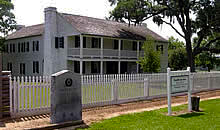Main Menu
Grimes County Data
Grimes County Communities & Places
Genealogy & History Links by USGHN
Important Grimes County Addresses
Sponsors
Grimes County Neighbors
Brazos County, Texas
Madison County, Texas
Montgomery County, Texas
Walker County, Texas
Waller County, Texas
Washington County, Texas
Other Websites
Welcome to Grimes County Texas Genealogy & History Network!
Welcome to the Grimes County, Texas Genealogy & History Network. Our purpose is to provide visitors with free resources for genealogical and historical research. To share your genealogy or history information, send an email to txghn@outlook.com and we will happily include it here. For other Texas Counties, visit the Texas Genealogy & History Network state website and go to the appropriate county. Thanks for visiting and good luck with your research! |
|
About Grimes County, Texas...

Grimes County, in southeastern Texas, lies forty miles northwest of Houston. Anderson, the county seat, is the third-largest town in Grimes County. Though the buffalo, bear, and wild hogs which once roamed the area disappeared in the 1800s, the county is still home to many wild animal species, including white-tailed deer, rabbit, raccoon, and opossum, and wild birds such as the mourning dove and bobwhite quail.
The earliest historical inhabitants of the area were the Bidai Indians. The Tonkawa Indians were also known to conduct raids in the area in search of game or plunder, and a group of them may have lived briefly in the bottoms of the lower Navasota River. By and large the Indian residents of what would become Grimes County lived amicably with the whites who settled among them in the early 1800s. Their presence, in fact, seems to have afforded the Anglo settlers a measure of protection against raids by hostile tribes such as the Comanche and Apache. The last fatal Indian raid in what would become Grimes County occurred in 1841. 
Settlement began with the founding of Stephen F. Austin's colony between the lower Brazos and Colorado rivers. In 1821 Andrew Millican took up residence along Holland Creek west of what is now Anderson. By the end of 1824 seven of Austin's original colonists had claimed land within what is now Grimes County. Early residents included the families of Francis Holland, Isaac Jackson, James Whiteside, Jesse Grimes, Caleb Wallace, Jared E. Groce, and Anthony Kennard. Before the outbreak of the Texas Revolution in 1836, a total of sixty-four heads of household obtained land grants within the future county from the Mexican government. In 1822 Jared E. Groce moved from Alabama with some ninety slaves and settled on the Brazos River near what is now Hempstead. There he planted what may have been one of the first cotton crops in the Austin colony. Soon he began cultivating the staple on a three-league tract in what is now southwestern Grimes County, where  perhaps as early as 1825 he constructed what may have been the first cotton gin in Texas.
perhaps as early as 1825 he constructed what may have been the first cotton gin in Texas.
The first post office in the area was established in December 1835 at the Fanthorp Inn, founded two years before by Englishman Henry Fanthorp. Settlers in this vicinity abandoned their homes in March and April of 1836 and to escape from the advancing Mexican army joined the mass eastward flight known as the Runaway Scrape. The area was quickly reoccupied after the battle of San Jacinto, and its development accelerated. It became part of Montgomery County, which was organized by the Congress of the Republic of Texas in 1837. On April 6, 1846, the first state legislature accepted the petition of local residents and established Grimes County, named in honor of Jesse Grimes, a signer of the Texas Declaration of Independence who was then representing the area in the state Senate. A vigorously contested election later in the year resulted in the designation of Anderson as the seat of government. In  1853 Madison County was carved out of northern Grimes County, which assumed its present boundaries in 1873, when Waller County was formed from territory in its southern extremity.
1853 Madison County was carved out of northern Grimes County, which assumed its present boundaries in 1873, when Waller County was formed from territory in its southern extremity.
After the Civil War, Grimes County was hampered by epidemics of cholera and yellow fever that killed hundreds in 1866 and 1867. Not until 1910 would Grimes County farms again be as valuable as they had been in 1860. Livestock production had suffered a grave setback; there were only about half as many cattle in the county in 1870 and 1880 as there had been before the war.
Grimes County provides numerous opportunities for hunting and fishing. Visitors are attracted to the area by its numerous historic sites and homes, as well the annual Renaissance Festival held in October and the Nostalgic Days celebration held each May.
The county has a total area of 802 square miles, of which 787 square miles is land and 15 square miles  (1.8%) is water. The population recorded in the 1850 Federal Census was 4,008. The 2010 census recorded 26,604 residents in the county.
(1.8%) is water. The population recorded in the 1850 Federal Census was 4,008. The 2010 census recorded 26,604 residents in the county.
Neighboring counties are Madison County (north), Walker County (northeast), Montgomery County (southeast), Waller County (south), Washington County (southwest), and Brazos County (west). The county seat is Anderson. Other communities in the county include Bedias, Iola, Navasota, Plantersville, Richards, Roans Prairie, Shiro, Stoneham, and Todd Mission.
Grimes County, Texas Records
Birth Records - The Texas Department of State Health Services has records from 1903 to present. Records for the last 75 years considered private and will only be provided to certain individuals. To obtain current information on who may obtain a record, how to submit a request and an official request form, see the Texas Department of State Health Services website or write to Texas Vital Records, Department of State Health Services, P.O. Box 12040, Austin, TX 78711-2040.
For older birth records you will have to write to the County Clerk of the applicable county. The existence of birth records prior to 1903 will vary widely from county to county. Local historical societies and genealogy collections in local libraries may be able to provide some information.
Death Records - The Texas Department of State Health Services has records from 1903 to present. Records for the last 25 years considered private and will only be provided to certain individuals. To obtain current information on who may obtain a record, how to submit a request and an official request form, see the Texas Department of State Health Services website or write to Texas Vital Records, Department of State Health Services, P.O. Box 12040, Austin, TX 78711-2040.
Marriage Records - The Texas Department of State Health Services can provide a verification letter of marriage for Texas marriages from 1966 to present. This is NOT a marriage license. To obtain a certified copy of a marriage license you must contact the County or District Clerk in the county or district where the marriage took place.
Local historical societies and genealogy collections in local libraries may be able to provide some information.
Divorce Records - The Texas Department of State Health Services can provide a verification letter of divorce for Texas divorces from 1968 to present. This is NOT a copy of the divorce decree. To obtain a certified copy of a copy of the divorce decree you must contact the County or District Clerk in the county or district where the divorce took place.
Local historical societies and genealogy collections in local libraries may be able to provide some information.




